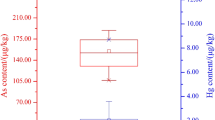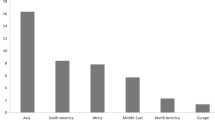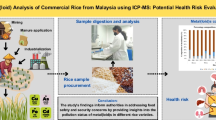Abstract
In the present study, six potentially toxic elements (PTEs), including chromium (Cr), arsenic (As), cadmium (Cd), lead (Pb), copper (Cu), and nickel (Ni), were determined in 41 domestic rice samples collected from Tehran using ICP-OES (inductively coupled plasma–optical emission spectrometry). The mean concentration of Cd, As, Cu, Pb, Cr, and Ni was found as 0.014 ± 0.01, 0.018 ± 0.005, 2.15 ± 1.84, 0.42 ± 0.31, 0.1 ± 0.16, and 0.48 ± 0.36 mg kg−1, respectively. Possible risks due to ingestion of PTEs via rice consumption for children and adults were assessed by Monte Carlo simulation. The 50th percentile of estimated Cr intake for children through domestic rice consumption exceeded the maximum tolerable daily intake. There was only a potential non-carcinogenic risk for single Cr exposure for children. The 95th percentile of the estimated hazard index (HI) for children and adults was 4.34 and 1.05, indicating a potential non-carcinogenic risk related to multiple PTE exposure. The lifetime cancer risk (ILCR) values derived from Cr, Ni, As, and Cd exposure exceeded the threshold value, indicating a carcinogenic risk due to PTEs’ exposure. The deterministic assessment demonstrates that the Tehran population may be at risk through domestic rice consumption. This study indicates that risk related to the exposure to multiple PTEs through the consumption of rice in adults and children in Tehran is recognized as an important issue, thus supporting the importance of cumulative analysis of the risk of exposure to PTEs through food. Finally, national strategic environmental assessment and technological solutions for monitoring and protecting freshwater, soil, waste management, and chemicals as a global concern policy are needed for public health.




Similar content being viewed by others
Data availability
Not applicable.
References
Abtahi M, Fakhri Y, Oliveri Conti G, Keramati H, Zandsalimi Y, Bahmani Z, Hosseini Pouya R, Sarkhosh M, Moradi B, Amanidaz N (2017) Heavy metals (As, Cr, Pb, Cd and Ni) concentrations in rice (Oryza sativa) from Iran and associated risk assessment: a systematic review. Toxin Rev 36:331–341
Agency UEP (2012) Integrated risk information system of the US Environmental Protection Agency. US Environmental Protection Agency (USEPA), Washington, DC, USA
Ameri Z, Hoodaji M, Rajaie M, Ataabadi M (2021) Optimizing modified rice bran for treating aqueous solutions polluted by Cr (VI) ions: isotherm and kinetics analyses. Qual Assur Saf Crops Foods 13:1–11
Amiri S, Moghanjougi ZM, Bari MR, Khaneghah AM (2021) Natural protective agents and their applications as bio-preservatives in the food industry: an overview of current and future applications. Ital J Food Sci 33:55–68
Antoine JM, Fung LAH, Grant CN (2017) Assessment of the potential health risks associated with the aluminum, arsenic, cadmium, and lead content in selected fruits and vegetables grown in Jamaica. Toxicol Rep 4:181–187
Antoine JM, Fung LAH, Grant CN, Dennis HT, Lalor GC (2012) Dietary intake of minerals and trace elements in rice on the Jamaican market. J Food Compos Anal 26:111–121
Bandumula N (2018) Rice production in Asia: key to global food security. Proc Natl Acad Sci India Sect B Biol Sci 88:1323–1328
Cai S, Zeng B, Li C (2023) Potential health risk assessment of metals in the muscle of seven wild fish species from the Wujiangdu reservoir. China Qual Assur Saf 15:73–83
Cancer IAfRo (1993) Cadmium and cadmium compounds. Monogr Eval Carcinog Risks Hum 58:119–237
Cancer IAfRo (1994) IARC monographs on the evaluation of carcinogenic risk to humans: some industrial chemicals. IARC Monogr Eval Carcinog Risk Hum: Some Ind Chem 60:560–560
Chauhan BS, Jabran K, Mahajan G (2017) Rice production worldwide. Springer International Publishing, Switzerland, p 563
Cilliers K, Muller CJ, Page BJ (2020) Trace element concentration changes in brain tumors: a review. Anat Rec 303:1293–1299
Commission E (2006) Setting maximum levels for certain contaminants in foodstuffs. Commission Regulation (EC) No 1881/2006. Off J Eur Communities: Legis 364:5
Custodio M, Espinoza C, Orellana E, Chanamé F, Fow A, Peñaloza R (2022) Assessment of toxic metal contamination, distribution and risk in the sediments from lagoons used for fish farming in the central region of Peru. Toxicol Rep 9:1603–1613
Djahed B, Taghavi M, Farzadkia M, Norzaee S, Miri M (2018) Stochastic exposure and health risk assessment of rice contamination to the heavy metals in the market of Iranshahr Iran. Food Chem Toxicol 115:405–412
Ebrahimi-Najafabadi H, Pasdaran A, Bezenjani RR, Bozorgzadeh E (2019) Determination of toxic heavy metals in rice samples using ultrasound-assisted emulsification microextraction combined with inductively coupled plasma optical emission spectroscopy. Food Chem 289:26–32
EN-BS 14084 (2003) Foodstuffs, determination of trace elements. Determination of lead, cadmium, zinc, copper and iron by atomic absorption spectrometry (AAS) after microwave digestion
EPA (2001) Risk assessment guidance for superfund: process for conducting probabilistic risk assessment, vol III
EPA (2004) Risk assessment guidance for superfund, vol I: human health evaluation manual (Part E, supplemental guidance for dermal risk assessment) Office of superfund remediation and technology innovation U.S. Environmental Protection Agency, Washington, DC
Eslamizad S, Yazdanpanah H, Hadian Z, Tsitsimpikou C, Goumenou M, AliAbadi MHS, Kamalabadi M, Tsatsakis A (2021) Exposure to multiple mycotoxins in domestic and imported rice commercially traded in Tehran and possible risk to public health. Toxicol Rep 8:1856–1864
Fakhri Y, Mousavi Khaneghah A, Conti GO, Ferrante M, Khezri A, Darvishi A, Ahmadi M, Hasanzadeh V, Rahimizadeh A, Keramati H (2018) Probabilistic risk assessment (Monte Carlo simulation method) of Pb and Cd in the onion bulb (Allium cepa) and soil of Iran. Environ Sci Pollut Res 25:30894–30906
FAO (2005) Rice is life: international year of rice 2004 and its implementation. International Rice Commission, p 133
FAO/WHO J (2004) Evaluation of certain food additives and contaminants: sixty-first report of the Joint FAO/WHO Expert Committee on Food Additives. World Health Organization, p 61
Fathabad AE, Shariatifar N, Moazzen M, Nazmara S, Fakhri Y, Alimohammadi M, Azari A, Khaneghah AM (2018) Determination of heavy metal content of processed fruit products from Tehran's market using ICP-OES: a risk assessment study. Food Chem Toxicol 115:436–446
Gao Y, Qian H, Zhou Y, Chen J, Wang H, Ren W, Qu W (2022) Cumulative health risk assessment of multiple chemicals in groundwater based on deterministic and Monte Carlo models in a large semiarid basin. J Clean Prod 352:131567
Hänsch R, Mendel RR (2009) Physiological functions of mineral micronutrients (cu, Zn, Mn, Fe, Ni, Mo, B, cl). Curr Opin Plant Biol 12:259–266
Hedayatifar R, Falahi E, Birjandi M (2011) Determination of cadmium and lead levels in highly consumed rice (Oryza Sativa L.) cultivated in Lorestan province and its comparison with national standards. Yafteh 12:15–22
Henley EJ, Kumamoto H (1996) Probabilistic risk assessment and management for engineers and scientists. IEEE Press, Wiley, Piscataway, New Jersey, p 615
Heshmati A, Mehri F, Karami-Momtaz J, Khaneghah AM (2020) Concentration and risk assessment of potentially toxic elements, lead and cadmium, in vegetables and cereals consumed in Western Iran. J Food Prot 83:101–107
Hu L, Wang X, Zou Y, Wu D, Gao G, Zhong Z, Liu Y, Hu S, Fan H, Zhang B (2022) Effects of inorganic and organic selenium intervention on resistance of radish to arsenic stress. Ital J Food Sci 34:44–58
IARC (2012) Review of human carcinogens–Part C: arsenic, metals, fibres and dusts, vol 100. IARC Monographs, Lyon, pp 196–211
ISIRI (2010) Food and feed-maximum limit of heavy metals. Inst Stand Indus Res Iran 12968:15
Jafari A, Kamarehie B, Ghaderpoori M, Khoshnamvand N, Birjandi M (2018) The concentration data of heavy metals in Iranian grown and imported rice and human health hazard assessment. Data Brief 16:453–459
Jafari K, Fathabad AE, Fakhri Y, Shamsaei M, Miri M, Farahmandfar R, Khaneghah AM (2021) Aflatoxin M1 in traditional and industrial pasteurized milk samples from Tiran County, Isfahan Province: a probabilistic health risk assessment. Ital J Food Sci 33:103–116
Kalantari N, Ghaffarpur M (2005) National report of the comprehensive study on household food consumption patterns and nutritional status of IR Iran, 2001-2003. Nutrition Research Group, National Nutrition and Food Technology Research Institute, Shaheed Beheshti University of Medical Sciences, Ministry of Health, Tehran, IR Iran, p 3
Karimi-Dehkordi M, Molavi Pordanjani M, Gholami-Ahangaran M, Mousavi Khaneghah A (2023) The detoxification of cadmium in Japanese quail by pomegranate peel powder. Int J Environ Health Res 1–11. https://doi.org/10.1080/09603123.2023.2211547
Kinuthia GK, Ngure V, Beti D, Lugalia R, Wangila A, Kamau L (2020) Levels of heavy metals in wastewater and soil samples from open drainage channels in Nairobi, Kenya: Community health implication. Sci Rep 10:1–13
Kukusamude C, Sricharoen P, Limchoowong N, Kongsri S (2021) Heavy metals and probabilistic risk assessment via rice consumption in Thailand. Food Chem 334:127402
Lindqvist R, Langerholc T, Ranta J, Hirvonen T, Sand S (2020) A common approach for ranking microbiological and chemical hazards in foods based on risk assessment-useful, but is it possible? Crit Rev Food Sci Nutr 60:3461–3474
Luo C, Sun J, Tan Y, Xiong L, Peng B, Peng G, Bai X (2022) Comparison of the health risks associated with exposure to toxic metals and metalloids following consumption of freshwater catches in China. Qual Assur Saf 14:1–12
Mahmudiono T, Hoseinvandtabar S, Mehri F, Borzoei M, Heidarinejad Z, Amin Nakoozadeh M, Daraei H, Atamaleki A, Fakhri Y, Mousavi Khaneghah A (2023) Potentially toxic elements (PTEs) in coastal sediments of Bandar Abbas city, North of Persian Gulf: an ecological risk assessment. Int J Environ Health Res 1–15. https://doi.org/10.1080/09603123.2023.2173154
Mohamed R, Zainudin BH, Yaakob AS (2020) Method validation and determination of heavy metals in cocoa beans and cocoa products by microwave-assisted digestion technique with inductively coupled plasma mass spectrometry. Food Chem 303:125392
Mohammadpour A, EmadiZ SMR, Ravindra K, Hosseini SM, Amin M, Samiei M, Mohammadi L, Khaksefidi R, Zarei AA (2023) The concentration of potentially toxic elements (PTEs) in drinking water from Shiraz, Iran: a health risk assessment of samples. Environ Sci Pollut Res 30:23295–23311
Moradi A, Honarjoo N, Fallahzade J, Najafi P (2013) Assessment of heavy metal pollution in soils and crops of industrial sites, Isfahan Iran. Pakistan J Biol Sci 16:97–100
Naseri M, Vazirzadeh A, Kazemi R, Zaheri F (2015) Concentration of some heavy metals in rice types available in Shiraz market and human health risk assessment. Food Chem 175:243–248
OECD Food Agriculture Organization of the United Nations (2017) OECD-FAO agricultural uutlook 2017–2026. OECD Publishing, Paris
Omar N, Praveena S, Aris A, Hashim Z (2015) Health risk assessment using in vitro digestion model in assessing bioavailability of heavy metal in rice: a preliminary study. Food Chem 188:46–50
Onyeaka H, Anumudu CK, Okolo CA, Anyogu A, Odeyemi O, Bassey AP (2022) A review of the top 100 most cited papers on food safety. Qual Assur Saf Crops Foods 14:91–104
Ozdemir S, Kilinc E, Oner ET (2019) Preconcentrations and determinations of copper, nickel and lead in baby food samples employing Coprinus silvaticus immobilized multi-walled carbon nanotube as solid phase sorbent. Food Chem 276:174–179
Perez-Rodriguez F (2020) Risk assessment methods for biological and chemical hazards in food, 1st edn. CRC Press, Boca Raton, p 527
Pinto E, Almeida A, Ferreira IM (2016) Essential and non-essential/toxic elements in rice available in the Portuguese and Spanish markets. J Food Compos Anal 48:81–87
Pirsaheb M, Hadei M, Sharafi K (2021) Human health risk assessment by Monte Carlo simulation method for heavy metals of commonly consumed cereals in Iran-Uncertainty and sensitivity analysis. J Food Compos Anal 96:103697
Praveena S, Omar N (2017) Heavy metal exposure from cooked rice grain ingestion and its potential health risks to humans from total and bioavailable forms analysis. Food Chem 235:203–211
Rahmani N, Mani-Varnosfaderani A (2022) Quality control, classification, and authentication of Iranian rice varieties using FT-IR spectroscopy and sparse chemometric methods. J Food Compos Anal 112:104650
Raissy M, Ansari M, Chaleshtori RS, Mahdavi V, Hadian Z, Lorenzo JM, Conti GO, Huseyn E, Khaneghah AM (2022) A systematic review of the concentration of potentially toxic elements in fish from the Persian Gulf: a health risk assessment study. Food Chem Toxicol 163:112968
Rastmanesh F, Ghazalizadeh S, Shalbaf F, Zarasvandi A (2022) Investigation of micronutrients and heavy metals in rice farms of Ahvaz and Bawie Counties, Khuzestan Province, Iran
Salehipour M, Ghorbani H, Kheirabadi H, Afyuni M (2015) Health risks from heavy metals via consumption of cereals and vegetables in Isfahan Province Iran. Hum Ecol Risk Assess: Int J 21:1920–1935
Sanaei F, Amin MM, Alavijeh ZP, Esfahani RA, Sadeghi M, Bandarrig NS, Fatehizadeh A, Taheri E, Rezakazemi M (2021) Health risk assessment of potentially toxic elements intake via food crops consumption: Monte Carlo simulation-based probabilistic and heavy metal pollution index. Environ Sci Pollut Res 28:1479–1490
Sharafi K, Nodehi RN, Yunesian M, Mahvi AH, Pirsaheb M, Nazmara S (2019a) Human health risk assessment for some toxic metals in widely consumed rice brands (domestic and imported) in Tehran, Iran: uncertainty and sensitivity analysis. Food Chem 277:145–155
Sharafi K, Yunesian M, Mahvi AH, Pirsaheb M, Nazmara S, Nodehi RN (2019b) Advantages and disadvantages of different pre-cooking and cooking methods in removal of essential and toxic metals from various rice types-human health risk assessment in Tehran households Iran. Ecotoxicol Environ Saf 175:128–137
Sharafi K, Yunesian M, Nodehi RN, Mahvi AH, Pirsaheb M, Nazmara S (2019c) The reduction of toxic metals of various rice types by different preparation and cooking processes–Human health risk assessment in Tehran households Iran. Food Chem 280:294–302
Smoke T, Smoking I (2004) IARC monographs on the evaluation of carcinogenic risks to humans. IARC, Lyon 1:1–1452
Suh M, Wikoff D, Lipworth L, Goodman M, Fitch S, Mittal L, Ring C, Proctor D (2019) Hexavalent chromium and stomach cancer: a systematic review and meta-analysis. Crit Rev Toxicol 49:140–159
Tsoi MF, Lo CWH, Cheung TT, Cheung BMY (2021) Blood lead level and risk of hypertension in the United States National Health and Nutrition Examination Survey 1999–2016. Sci Rep 11:1–6
Wang C, Yang Y, Wu N, Gao M, Tan Y (2019) Combined toxicity of pyrethroid insecticides and heavy metals: a review. Environ Chem Lett 17:1693–1706
Wei J, Cen K (2020) Contamination and health risk assessment of heavy metals in cereals, legumes, and their products: a case study based on the dietary structure of the residents of Beijing. China J Clean Prod 260:121001
World Health Organization (2019) Preventing disease through healthy environments: exposure to arsenic: a major public health concern. WHO/CED/PHE/EPE/19.4.1
Xiao-Mei H, Jin Y, Chao L, Xiao-Jun F, Yuan Z (2023a) Impact of watershed habitat quality based on land use: a case study of taking Ciyao River Basin. Qual Assur Saf 15:18–31
Xiao-Mei H, Jin Y, Chao L, Xiao-Jun F, Yuan Z (2023b) Analysis of hydrochemical characteristics and genesis of water-deficient rivers in China: a case study of the Ciyao River Basin in Shanxi Province. Qual Assur Saf Crops Foods 15:32–43
Yousefi MH, Abbasi E, Hadidi M, Hashemi S, Ghadimi AH, Yousefinejad S, Arfaeinia H, Yousefinejad A, Kowalczewski PŁ, Tomkowiak A (2023) Simultaneous analysis of mycotoxins, potentially toxic elements, and pesticides in rice: a health risk assessment study. Toxins 15:102
Zheng J, Li M, Tang B, Luo W, Ma Y, Ren M, Yu Y, Luo X, Mai B (2021) Levels, Spatial distribution, and impact factors of heavy metals in the hair of metropolitan residents in China and human health implications. Environ Sci Technol 55:10578–10588
Zheng S, Wang Q, Yuan Y, Sun W (2020) Human health risk assessment of heavy metals in soil and food crops in the Pearl River Delta urban agglomeration of China. Food Chem 316:126213
Zoghi A, Salimi M, Mirmahdi RS, Massoud R, Khosravi-Darani K, Mohammadi R, Rouhi M, Tripathy AD (2022) Effect of pretreatments on bioremoval of metals and subsequent exposure to simulated gastrointestinal conditions. Qual Assur Saf 14:145–155
Funding
The National Nutrition and Food Technology Research Institute, Shahid Beheshti University of Medical Sciences, Tehran, IR, supported this study. Iran (Grant No. 25753).
Author information
Authors and Affiliations
Contributions
Amin Mousavi Khaneghah: conceptualization, investigation, review and editing. Mahdie Kamalabadi: investigation, literature searching, writing, original draft. Ali Heshmati: review and editing. Zahra Hadian: literature searching, writing, original draft, conceptualization, data curation, resources, supervision.
Corresponding author
Ethics declarations
Ethics approval
Not applicable.
Consent to participate
The authors declare their Consent to Participate in this article.
Consent for publication
The authors declare their Consent to Publish this article.
Conflict of interest
The authors declare no competing interests.
Additional information
Responsible Editor: Philippe Garrigues
Publisher’s note
Springer Nature remains neutral with regard to jurisdictional claims in published maps and institutional affiliations.
Supplementary information
ESM 1
(DOCX 664 kb)
Rights and permissions
Springer Nature or its licensor (e.g. a society or other partner) holds exclusive rights to this article under a publishing agreement with the author(s) or other rightsholder(s); author self-archiving of the accepted manuscript version of this article is solely governed by the terms of such publishing agreement and applicable law.
About this article
Cite this article
Mousavi Khaneghah, A., Kamalabadi, M., Heshmati, A. et al. The concentration of potentially toxic elements (PTEs) in Iranian rice: a dietary health risk assessment study. Environ Sci Pollut Res 30, 90757–90771 (2023). https://doi.org/10.1007/s11356-023-28442-8
Received:
Accepted:
Published:
Issue Date:
DOI: https://doi.org/10.1007/s11356-023-28442-8




